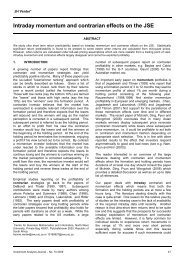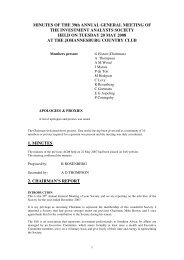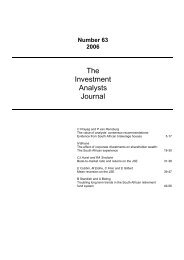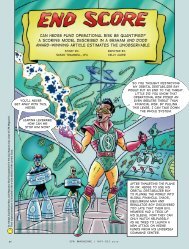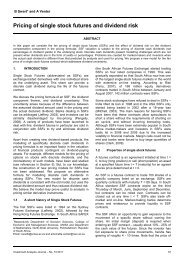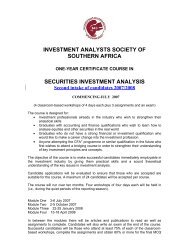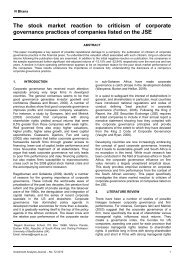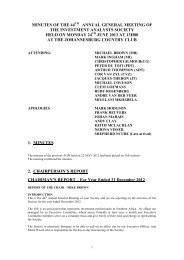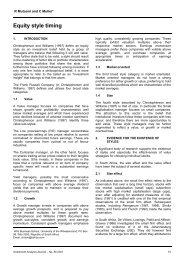Accounting is Broken - Investment Analysts Journal
Accounting is Broken - Investment Analysts Journal
Accounting is Broken - Investment Analysts Journal
You also want an ePaper? Increase the reach of your titles
YUMPU automatically turns print PDFs into web optimized ePapers that Google loves.
Stern Stewart & Co.<br />
Although such charges can re p resent major traumas for re p o rted earnings, the charges are<br />
non-cash non-events for EVA. The EVA treatment <strong>is</strong> entirely cons<strong>is</strong>tent with the market’s<br />
reaction to AOL Time Wa rn e r ’s d<strong>is</strong>closure that it would take a $54 billion impairm e n t<br />
c h a rge to its earnings. Upon the announcement of the massive loss, the company’s stock<br />
price did not budge.<br />
T h rough the EVA<br />
pr<strong>is</strong>m, re s t ru c t u r i n g<br />
losses are not seen as<br />
inexplicable and eminently<br />
forg e t t a b l e<br />
c h a rges to earn i n g s .<br />
They are memorialized<br />
as investments intended<br />
to streamline operat<br />
i o n s .<br />
Strategic investments<br />
a re new projects that<br />
will take some time to<br />
fully bear their fru i t .<br />
They produce insuff i-<br />
cient earnings to cover<br />
the cost of capital in<br />
their early years even<br />
though they are likely to<br />
p roduce oodles of EVA<br />
down the ro a d .<br />
The proposed new accounting also casts a brighter light on dec<strong>is</strong>ions to re s t ru c t u re a business.<br />
Through the EVA pr<strong>is</strong>m, re s t ructuring losses are not seen as inexplicable and eminently<br />
forgettable charges to earnings. They are memorialized as investments intended to<br />
s t reamline operations. As such, re s t ructuring investments can be analyzed on the same<br />
financial terms as any other investment a company might make.<br />
Most corporate re s t ructuring campaigns are more complicated than a mere asset write<br />
down because usually they include additional cash expenditures for such non-re c u rr i n g<br />
items as severance, relocations, environmental remedies, contract cancellation penalties,<br />
and so forth. As with goodwill impairments, the asset write downs that are attendant to<br />
re s t ructuring campaigns are completely inconsequential. Charges relating to the nonre<br />
c u rring cash outlays, however, are treated as investments to streamline and focus business<br />
operations. When those charges are taken out of earnings and added back to the balance<br />
sheet they have the effect of increasing capital.<br />
With that treatment, re s t ructuring dec<strong>is</strong>ions can easily be subjected to the same capital budgeting<br />
criteria as any other investments a company might make. Managers should decide<br />
to re s t ru c t u re when they believe that the on-going cash flow benefits stemming from a re o r-<br />
ganization will more than offset the cost of capital associated with the non-re c u rring upf<br />
ront cash outlays. To judge whether that has happened, investors will want managers to<br />
capitalize their re s t ructuring investments and to measure the payoffs against the cost of that<br />
additional capital<br />
The new accounting <strong>is</strong> also effectively the same as shifting from successful eff o rts to full cost<br />
accounting. A re s t ructuring charge or divestiture loss <strong>is</strong> considered more often the re s u l t<br />
of intelligent r<strong>is</strong>k taking than widespread and inherent management incompetence. The<br />
balance sheet once again should not be viewed as an aggregation of assets so much as an<br />
accumulation of capital—the cash that has gone into the business less the cash that has come<br />
out of it.<br />
However the rev<strong>is</strong>ed rules are interpreted, the effect <strong>is</strong> to give managers and investors a far<br />
better avenue to judge the incremental value of dec<strong>is</strong>ions in a dynamic r<strong>is</strong>k-taking enviro n-<br />
ment and to liberate assets now held hostage by outdated accounting conventions.<br />
To reiterate, the recommended new accounting rule <strong>is</strong> to couple “pro - f o rma” income with<br />
“ p ro - f o rma” capital. Restructuring charges and divestiture losses should be added back<br />
both to earnings and to capital.<br />
Strategic <strong>Investment</strong>s<br />
Switching from the back door of investing to the front, strategic investments are new projects<br />
that will take some time to fully bear their fruit. They produce insufficient earnings to<br />
cover the cost of capital in their early years even though they are likely to produce oodles of<br />
E VA down the road. A start-up biotech company like Amgen went almost 10 years after its<br />
public offering before profits began to gush in from its early stage investments. Even a<br />
restaurant chain typically finds it takes three years from the day a new restaurant <strong>is</strong> opened<br />
b e f o re word of mouth builds traffic to the level at which profit can cover the cost of capital.<br />
Measuring EVA without an adjustment will lead to a dramatic understatement of perf o r-<br />
mance in the initial building years and an overstatement in the lush later years. The same <strong>is</strong><br />
t rue also for accounting earnings and ROE, but EVA aspires to be better than those metrics.<br />
22




